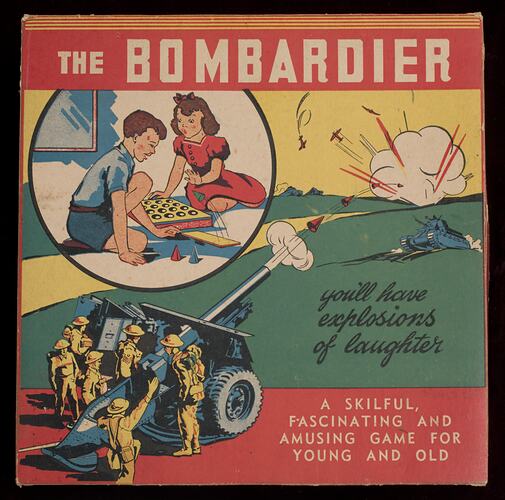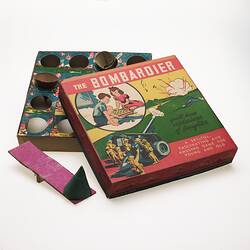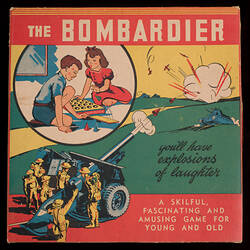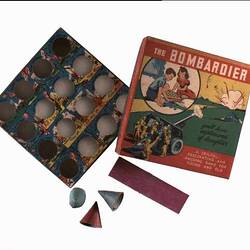Summary
Board game 'The Bombardier', made by Paul Bruce & Co. Pty Ltd in Brunswick, circa 1939. Consists of box containing a game board with 16 large holes or targets. Coloured cone-shaped pieces with lead tips are flipped into the holes using a rectangle of cardboard. The images on the box and game board represent a World War II tank battle and children imitating the battle with 'The Bombadier' game.
The game is optimistically described as 'a skilful, fascinating and amusing game for young and old' - 'you'll have explosions of laughter'.
Physical Description
Board game in box. Cardboard lid of box has a coloured drawing of a girl in a red dress and a boy wearing a blue short sleeved shirt and shorts playing the game; also soldiers firing shells from a canon, a tank, and a few aeroplanes. The reverse of the lid contains instructions on how to play the game printed in blue ink. Printed drawings of an aeroplane, tank and battleship are on all four sides. Blue border around lid. Bottom of box plain cardboard. Box contains another box with 16 large holes or targets. Coloured cone-shaped pieces with lead tips fit into the holes. A rectangle of cardboard is used to flick the cones.
Significance
World War II changed life for everyone - including children. While fathers were away fighting 'Mr Hitler', many mothers worked long hours in offices and factories. Food and clothing were rationed, and children helped grow vegetables in backyard 'victory gardens'. After Japan entered the war in 1942 and invasion threatened, the fear of bombing hung in the air. Some city children were evacuated to rural areas. Many families built air-raid shelters in suburban backyards. Trenches were dug across school playgrounds, and air-raid drills were held. Yet wartime could be exciting, too. Military marches through the city streets, fireside games of strategy and battleships, and heroic tales of soldiers in far-off lands - all lit the imagination of many a Melbourne child. But reality hit hard for those children whose loved ones did not come home. (Melbourne Story exhibition label, 2008)
More Information
-
Collecting Areas
-
Acquisition Information
Donation from Kerry Smith, 05 Feb 1991
-
Manufacturer
Paul Bruce & Co. Pty Ltd, Brunswick, Greater Melbourne, Victoria, Australia, 1939 or later
-
Inscriptions
Printed, front, white text: 'THE BOMBARDIER / A SKILFUL, / FASCINATING AND / AMUSING GAME FOR / YOUNG AND OLD / you'll have / explosions of / laughter'. Printed, front side: 'PATENT A.P. No. 11008/43/ MANUFACTURED BY PAUL BRUCE & CO. PTY. LTD., BRUNSWICK, VIC'. Extensive text in blue ink on reverse.
-
Classification
-
Category
-
Discipline
-
Type of item
-
Overall Dimensions
254 mm (Width), 45 mm (Depth), 259 mm (Height)
-
Keywords
Home Fronts, Pastimes, Recreation, Wars & Conflicts, World War II, 1939-1945








